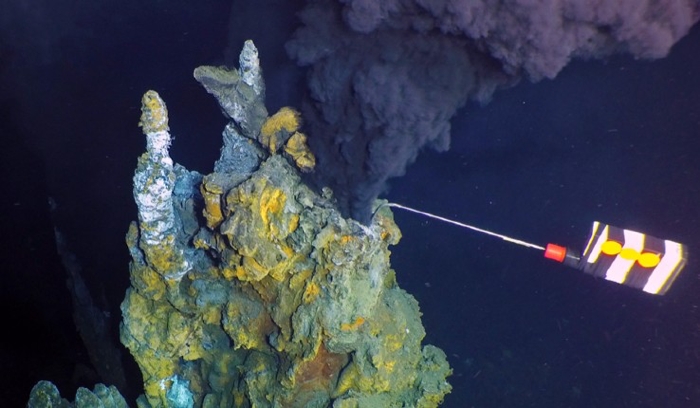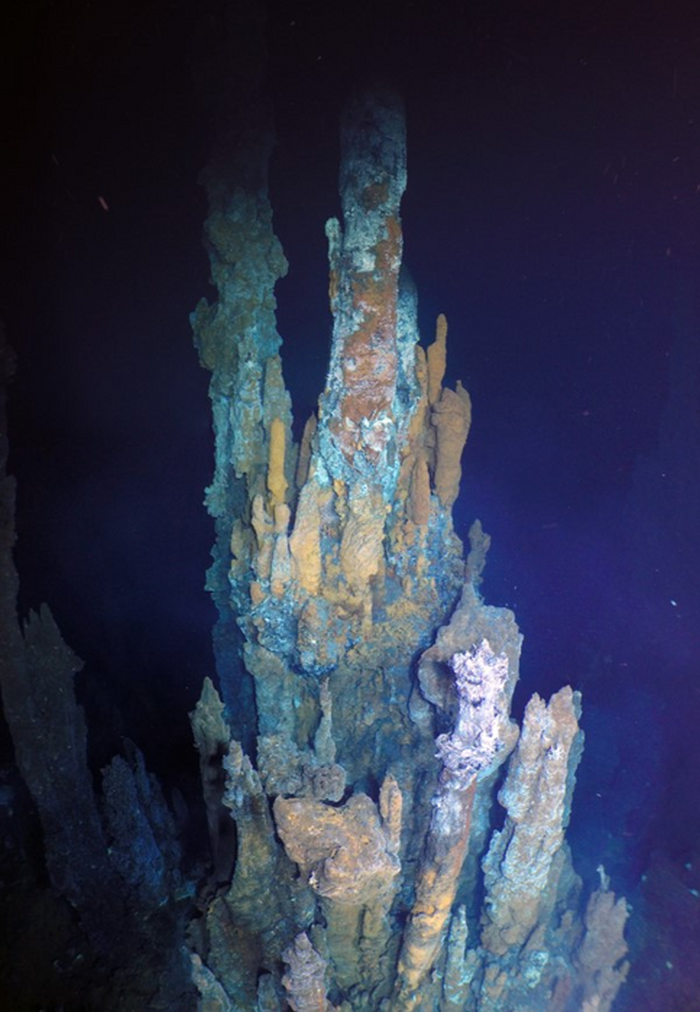A massive field of hydrothermal vents on the seafloor in the dark depths of the East Pacific ocean is the hottest and largest discovered in the region yet.
Not only that, but it's in a place scientists didn't expect to find active vents, never mind an entire system of them, hundreds of meters from the axis of a volcanic ridge.
The discovery, scientists say, could have a significant impact on our understanding of vent systems, and the role they play in ocean ecosystems.
The field was discovered by a team of scientists using autonomous underwater vehicles to map the seafloor at depths inhospitable to human explorers.
In data obtained from Woods Hole Oceanographic Institution's AUV Sentry, the team saw a region of huge spires, standing up to three stories tall at depths of 2,560 (8,400 feet) meters below the surface – in the silent, permanently dark bathypelagic depths.
 A vent monitored with a temperature logger. (WHOI/NDSF/ROV Jason/NSF)
A vent monitored with a temperature logger. (WHOI/NDSF/ROV Jason/NSF)
Initially, the team thought the vents were extinct, but a closer look revealed otherwise.
"We were astounded that not only was the field very active, but it is larger in area and hotter in origin temperature than any other hydrothermal vent field known along this portion of the East Pacific Rise that has been studied for the past 30 years," says marine geologist Daniel Fornari of WHOI.
Hydrothermal vents are home to some of the most fascinating ecosystems on Earth. They are openings on the seafloor where heat and chemicals are vented from our planet's crust, usually associated with volcanic activity.
The vent plumes themselves can be scorchingly hot, over 400 degrees Celsius (750 Fahrenheit), yet life thrives in their immediate proximity.
Most life on Earth relies on a photosynthetic food web, but down in the bathypelagic darkness, life takes a different route. The chemicals deposited by the vents feed a food web based on chemosynthesis, harnessing chemical reactions for energy rather than sunlight.
Not only is this an amazing testament to "life finds a way", but it reveals a mechanism whereby life might exist on other worlds, such as the icy Solar System moons Enceladus and Europa.
They're also deeply important to the ocean as a whole, supplying a transport system from Earth's interior that helps regulate ocean chemistry and temperature. But, because they're often found at depths that aren't particularly hospitable to humans, our understanding of them is really incomplete.
Usually, searches for hydrothermal vent systems in the East Pacific are concentrated near ridge axes, and loci of volcanic activity.
Here, a team led by chemical oceanographer Jill McDermott of Lehigh University was seeking to better map the area west and east of the East Pacific Rise axial trough, using Sentry's sonar to generate three-dimensional maps of the seafloor.
 A spectacular vent chimney at the site. (WHOI/NDSF/ROV Jason/NSF)
A spectacular vent chimney at the site. (WHOI/NDSF/ROV Jason/NSF)
"The mapping work provides a detailed picture of the seafloor so that we can monitor and quantify changes that occur when the next volcanic eruption happens along this portion of the East Pacific Rise ridge axis," McDermott explains.
It was during this survey that the team saw the pinnacles of a huge vent field, 750 meters east of the ridge axis, and 5 to 7 kilometers north of the closest known active on-axis vents.
Sampling of nine of the vents revealed temperatures of 368 degrees Celsius, with elements whose presence suggested origin temperatures even higher – a minimum of 437 degrees Celsius for the observed iron-manganese ratio.
In all, the field covered an area equivalent to a football field, the team said. Its proximity to a fault line suggests that it is controlled by tectonic activity.
The scientists believe that the vents may help re-seed nearby hydrothermal ecosystems following volcanic eruptions. Two eruptions have occurred on the East Pacific Rise in recent decades; one from 1991 to 1992, and another in 2005 to 2006. Another is expected to occur in a few years, the researchers said.
Wider exploration of the deep seafloor may reveal more vent fields in unexpected locations, which in turn can further our understanding of how these almost-alien ecosystems work.
"There is much still left to be discovered about deep-sea vents along the global mid-ocean ridge, both in terms of where they are located as well as their geological, geochemical and biological characteristics," McDermott says.
"I hope our study will motivate future research efforts to target mapping off-axis areas along the global mid-ocean ridge crest to better quantify the extent of off-axis versus on-axis hydrothermal venting."
The research has been published in PNAS (link not yet live at time of writing).






No comments:
Post a Comment